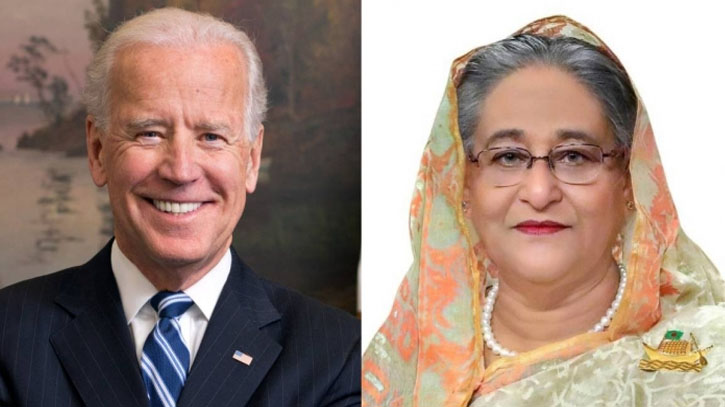What did America want from Sheikh Hasina?
Sheikh Hasina's Awami League came under great pressure at home and abroad from the very beginning regarding the results of the 2018 parliamentary elections in Bangladesh. The government had to face one rumor after another, controversy, criticism and various demands. Various domestic and foreign conspiracies continued in full swing. Jamaat-e-Islami and like-minded extremist Islamic parties, teachers and students of Qaumi Madrasas and various banned militant organizations became active again. A new organization, Jamaat-ul-Ansar Fil Hindal Eswarakiya, was formed by involving the Kuki-Chin National Front of the mountains, Al-Qaeda Subcontinent Branch, old and new JMB and Rohingya jihadists. And Hizb-ut-Tahrir played the role of coordinator in strategy formulation and communication work. It is worth noting that from 2013-19, Al-Qaeda in the Subcontinent (Ansarullah Bangla Team or Ansar Al Islam) and the old and new JMB carried out about 70 operations, killing hundreds of people, establishing a reign of terror. However, after the horrific attack on the Holy Artisan in 2016, the government began anti-militancy operations, but their activities slowed down.
In the meantime, when Republican President Donald Trump lost the election at the end of 2020, Joe Biden of the war-mongering Democrat party came to power, and on the advice of former Secretary of State Hillary Clinton, he started getting involved in wars and conflicts in different parts of the world, just like his predecessors Barack Obama and George Bush. He took various steps to weaken China, Russia, and India. On December 10, 2021, the Biden administration imposed sanctions on RAB and some top officials of this specialized force. It can easily be assumed that negotiations were underway with Bangladesh on some issues with America. That relationship cooled even more when the Russia-Ukraine war broke out in 2022, which initiated a complex polarization in international politics. Although this war began eight years ago, it turned into a bloody war with the direct support of the Biden administration. The world was then divided into two and supported America and Russia. Again, many countries tried to maintain good relations with these two superpowers. But America wanted unconditional support and a clear position against Russia. The Biden administration considered countries that had normal diplomatic and trade relations with Russia as dangerous enemies. Among them were the governments of Sheikh Hasina of Bangladesh, Narendra Modi of India, and Imran Khan of Pakistan.
Over the next two years, the governments of Pakistan and Bangladesh fell, and anti-government protests and criticism in India gradually escalated to dangerous levels. Many political analysts, including Imran Khan, believe that the Biden administration is plotting to overthrow him.
At the same time, Sheikh Hasina has repeatedly said that America is trying to remove her in various ways. The Biden administration is supporting the formation of a separate state in the southeast of Bangladesh by supporting the Arakan Army, Kuki-Chin and Rohingya armed rebels by passing the Burma Act and has sought allocation of gas blocks in the deep sea of the Bay of Bengal without tender. Biden also wanted Bangladesh to join the Indo-Pacific Strategy and the Quad and to sign a military agreement (GSUMIA). Although these demands were not publicly announced by officials in Washington or Dhaka, in late July 2023, Ambassador Peter Haas revealed his government's five goals for the first time at an army event, one of which was joining the military agreement and the Indo-Pacific and not sending the Rohingya back until the situation in Rakhine State normalizes.
Sheikh Hasina did not want to damage relations with China and India by agreeing to these American proposals. As a result, at one stage of the negotiations, the Biden administration announced a separate visa policy for Bangladesh over the issues of election fraud and human rights situation.
In this conspiracy, America openly used the opposition alliance led by BNP, the war criminal Jamaat and other extremist Islamic organizations, local and foreign media, and representatives of civil society. This group had been trying to overthrow the Awami League government for many years. As a result, everyone's goals coincided.
When anti-government protests began in 2021 after the coronavirus outbreak subsided, many were suspicious of Ambassador Peter Haas's self-imposed role as coordinator. At the same time, several cases were initiated against Nobel laureate economist and former MD of Grameen Bank Professor Muhammad Yunus. In addition, the Awami League government tried to bring back some of the convicted defendants in the Bangabandhu assassination case from America and Canada. On the other hand, BNP's anger was growing as former Prime Minister Khaleda Zia was imprisoned in a corruption case since 2018. Again, after the registration and symbol of the Jamaat were revoked, it strategically formed the AB Party and started activities against the government involving civil society, journalists, and college and university teachers and students.
While all the conspiracies to weaken the Awami League were going on, many leaders and activists showed their failure to assume a responsible role as a large party. Many indulged in unethical activities due to greed for power and money and increased divisions within the party. In addition, despite criticism at home and abroad against those involved in corruption and terrorist activities, the support and acceptance of the Awami League by the people decreased alarmingly.
As a result, when student organizations mainly from Jamaat, AB Party, Hizb ut Tahrir, and Gana Odhikar Parishad started a movement at Dhaka University in June in the name of eliminating quota discrimination, the media and civil society considered them to be ordinary students and gave them immense support and strongly criticized the government's wrong steps and limitations.
Although the opposition parties openly supported the movement from the beginning, the leaders and activists were asked to take to the field, after the US State Department falsely reported two deaths on July 15. The next day, clashes broke out across the country and six people were killed, and the government was in trouble. The conspirators got their issue by dumping the bodies and gained public sympathy by spreading widespread rumors on social media. Basically, the biased view and incompetence of the media, the anti-government attitude of university teachers and civil society played a major role in creating discontent among the people.
At the same time, according to common journalistic principles, no media outlet made any attempt to investigate the political identities and goals of the protesters, even though the leaders were openly emphasizing their readiness to paralyze the entire country, including Dhaka, and to shed blood to achieve their demands.
Finally, after the change of the situation on August 5, many student leaders and organizers bravely revealed their political identity in the face of attacks by Jamaat and armed militants. On the other hand, Chief Advisor Professor Muhammad Yunus made a bold remark at a meeting in New York in September that this movement was very well planned. In addition, a central student coordinator said in a talk show that if they had not set fire to various establishments including the metro rail and had not created anarchy by killing policemen, it would not have been easy to overthrow the government. Apart from this, BNP student leaders say that more than four hundred of their leaders and activists were killed in this movement and that at one stage of the movement, when the students were not in the field, they made fake ID cards and occupied the streets. In addition, it was later learned that some took to the streets with sophisticated weapons and killed protesters and policemen with sniper rifles from various rooftops.
In addition, the protesters attacked police stations and prisons, killed hundreds of officers, and looted thousands of weapons. As a result, the interim government had to issue an order of impunity, which is against the rule of law. The UN human rights organization has criticized this impunity and the UN fact-finding mission has expressed concern over the lack of accurate information. In addition, since August 5, the wholesale killing of Awami League leaders and activists, the destruction of monuments of the Liberation War and sculptures and museums of the Father of the Nation Bangabandhu Sheikh Mujibur Rahman, minority oppression, looting and arson, forced dismissals, nepotism in appointments from the advisory council to the administration, anarchy in the judiciary, and a crackdown on the media have greatly reduced the public support for the current government within five months.
As a result, the student coordinators are now resorting to various tricks to survive with the help of Jamaat, AB Party and militant organizations, and are trying to win by force somewhere. Most recently, they have announced that they will publish the July Revolution Declaration on December 31. Experts believe that through this, they may try to abolish the constitution and form a revolutionary government. However, the Yunus government has already denied the involvement of the student coordinators in this initiative and the BNP is directly opposing this declaration.
Now everyone understands why Yunus said that the students have canceled everything old by pressing the reset button. It means that in the new Bangladesh, the Jamaat-led government will reconsider the secular constitution, the liberation war, the position of Bangabandhu and the Awami League. The announcement of canceling the Constitution Day on March 7, August 15 and November 4, the decision not to accept Bangabandhu as the Father of the Nation, carries that indication. In addition, the Yunus government is also giving the freedom to cancel “Joy Bangla” as the national slogan through the court and arrest anyone who raises this slogan or beat him to death if he wants.
On the other hand, the lifting of the ban on Jamaat-Shibir, the cancellation of Khaleda Zia's sentence, the dismissal of Yunus' tax evasion and other cases, the acquittal of all the accused in the August 21 grenade murder case, the granting of bail to more than a hundred militants including the top leader of Al-Qaeda and the release of two dozen top terrorists have made it clearer who is running the government. The latest information is that Nasimul Ghani, who was appointed as the secretary of the Ministry of Home Affairs last week, was one of the architects of the establishment of Hizb ut-Tahrir in 2000. As a result, it is also easy to imagine how the militants are being released from prison. They are openly calling for armed jihad, why the interconnection of Pakistani politicians, businessmen and militants' activities in this country has suddenly increased and why student coordinators are demanding a fundamentalist constitution.

